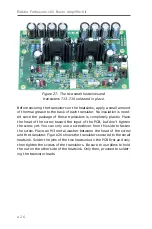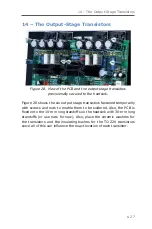
●
13
(amplifier PCB) connect the output of the amplifier to K6 (LS+) and K7
(LS–) on the protection PCB and from there via the relay and output
terminals K8 and K9 to the loudspeaker. “Faston” connectors K8 and
K9 (PCB versions) make sure the series resistance of this connection
to the cable is extremely low.
On the finished amplifier, the screw heads should be on the back of the
heatsink. Black screws won’t stand out that much when looking at the
back of the heatsink. Black Allen-type screws are used for the tran-
sistors (with internal hexagonal recesses). Strangely enough, black
16-mm long screws are few and between at many electronic part dis-
tributors.
Selected parts shown in the photos may have different values or
shapes in your kit. This is because the amplifier shown was a first
prototype for testing.
3 – Tools Needed
• Soldering equipment for through-hole components. Soldering
iron rated at 100 watts minimum. Also recommended is an ex-
tra-long tip for soldering the transistors in the output stage.
• Small pliers with flat jaws.
• Pliers with special jaws for pressing a thermal relief (bend) in
the leads of the push-pull transistors. Alternatively: pliers with
round jaws.
• Pozidriv screwdriver (depends on the exact type of screws in the
kit).
• 2.5-mm tool for hex screws (Allen wrench; also depends on the
exact type of screws in the kit).
• Drill stands or similar tool with 3-mm drill bit to drill 12 3-mm
holes in the large heatsink. Consider using a 3.2-mm drill bit if
accuracy of drilling is sub optimal).
• 10-mm drill bit or similar rod or tube for use as a former to wind
the air inductor on.
3 – Tools Needed












































